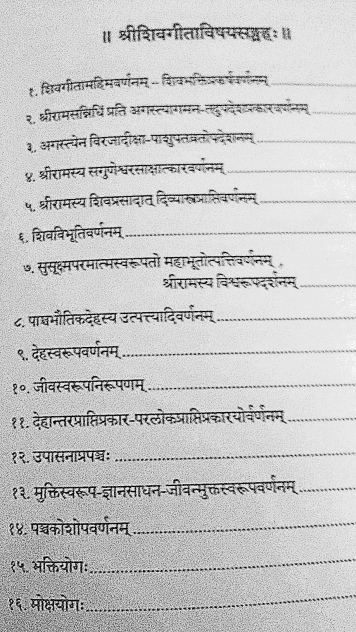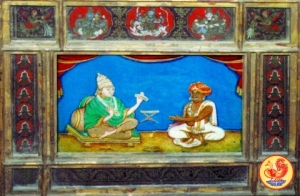
Sri Gurubhyo Namaha
The Shiva Gita is a scripture that appears in the Padma Purana as a teaching by Sadashiva to Sri Rama in the form a dialogue. The 24th Jagadguru Shankaracharya of Sringeri, Sri Abhinava Nrisimha Bharati, had penned a wonderful commentary on this treatise, known as Shiva Gita Bhaashya (list of topics shown on the right). This was published recently in 2012 by the Shankara Advaita Research Centre sringeri. Here is a short note on the Jagadguru from http://www.sringeri.net/jagadgurus/the-later-acharyas-2. A short write-up follows, based on the commentary of Chapter 7 (Manifestation of Jagat (universe) and Vishwarupadarshanam of Shiva shown to Lord Rama).
__________
Sri Abhinava Nrisimha Bharati (1600 – 1623)

तं सर्वभूताभयदं विभवैरन्वितं परम् ।
नारसिंहं गुरुं चापि नवं ज्ञानार्णवं भजे ॥
He removes fear from all the human minds He is majestic and magnanimous An ocean of spiritual knowledge Hail Abhinava Nrisimha Bharati!
An expert in mantrasastra, Sri Abhinava Nrisimha Bharati was an adept of a high order. A commentary on the Shiva Gita, that he wrote, is an outstanding work. He installed a linga named Rameshwara in 1602 at Rudrapada. He also founded an agrahara on the Paschimavahini and named it Narasimhapura after his Guru. When the Acharya visited the Malahanikeshwara temple and noticed the absence of any Ganesha image there, he painted with a piece of turmeric a figure of the God on one of the front pillars and worshipped it. Ever since, the outline of Ganesha on the pillar has been bulging out presenting a bas-relief, and has come to be known as Stambha Ganapati. The granite stone behind the idol now sounds hollow inside, while it is quite solid over the rest of the pillar.
________________
Notes from Chapter 7 (Manifestation of Jagat (universe) and Vishwarupadarshanam of Shiva shown to Lord Rama)
Bewildered by Bhagavan Shiva’s nature as a seemingly limited being (with a form) and yet claiming to be the entity responsible for the existence of everything, Sri Rama asks –
श्री रामो उवाच
śrī rāmo uvāca
परिच्छिन्नपरिमाणे देहे भगवतस्तव।
उत्पत्तिः पञ्चभूतानां स्थितिर्वा विलयः कथम्॥ २
paricchinnaparimāṇe dehe bhagavatastava|
utpattiḥ pañcabhūtānāṁ sthitirvā vilayaḥ katham|| (2)Being of a limited form (such as that of particulars like that of a male form, etc.), how do You manifest, sustain and unmanifest the Panchabhutas (which are the basis for entire manifested universe) ?
Not unlike the Bhagavad Gita in which Bhagavan as Krishna shows His vishwarupadarshana to Arjuna, here too Bhagavan Parameshwara gives Sri Rama the power of divine vision of seeing the Vishwarupa-darshana of Bhagavan Shiva.
श्रीभगवानुवाच
śrībhagavānuvācaमयि सर्वं यथा राम जगदेतच्चराचरम्।
वर्तते तद्दर्शयामि न द्रष्टुं क्षमते भवान्॥
mayi sarvaṁ yathā rāma jagadetaccarācaram|
vartate taddarśayāmi na draṣṭuṁ kṣamate bhavān||O Rama! I will show you how the entire Jagat consisting of all the moving and immovable entities are manifest from Me, to see which your physical vision will not suffice.
दिव्यं चक्षुः प्रदास्यामि तुभ्यं दशरथात्मज।
तेन पश्य भयं त्यक्त्वा मत्तेजोमण्डलं ध्रुवं॥
divyaṁ cakṣuḥ pradāsyāmi tubhyaṁ daśarathātmaja|
tena paśya bhayaṁ tyaktvā mattejomaṇḍalaṁ dhruvaṁ||O Son of Dasharatha! Let Me give you the divine vision by which you will able to see My Divine Nature without fail.
Having obtained that power given by Ishwara, Sri Rama proclaims in joy the glory of Parameshwara –
श्री रामो उवाच
śrī rāmo uvācaनमस्सच्चिदम्भोधिहंसाय तुभ्यम्
नमः कालकण्ठाय कालात्मकाय।
नमस्ते समस्ताघसंहारकर्त्रे
नमस्ते मृषाचित्तवृत्त्येकभोक्त्रे ३७
namassaccidambhodhihaṁsāya tubhyam
namaḥ kālakaṇṭhāya kālātmakāya|
namaste samastāghasaṁhārakartre
namaste mṛṣācittavṛttyekabhoktre 37Prostrations to Him who is the Swan on the Infinite-Ocean-waters of Knowledge of the sages,
Prostrations to the Blue-Throated One and the One in the form of Time,
Prostrations to the One who is the destroyer of all paapas,
Prostrations to the Experiencer of all the modifications of the mind.
Lord Rama then revels in the Vedantic understanding that Ishwara alone is manifest as the entire universe. Nothing exists separate from Him, yet He is unaffected by the various manifestations, the changes, the properties that one sees in the manifestations. Sri Rama understands that Ishwara alone is, while all the individual manifestations are only appearances, like apparently-limited pot-space, or like the apparently-existing dream.
व्याप्नोषि सर्वा विदिशो दिशश्च
त्वं विश्वमेकः पुरुषः पुराणः।
नष्टेऽपि तस्मिन् तव नास्ति हानिः
घटे विनष्टे नभसो यथैव॥
vyāpnoṣi sarvā vidiśo diśaśca
tvaṁ viśvamekaḥ puruṣaḥ purāṇaḥ|
naṣṭe’pi tasmin tava nāsti hāniḥ
ghaṭe vinaṣṭe nabhaso yathaiva||You, the Beginningless Non-Dual One, encompass all directions and the entire Jagat,
Even when the Manifest Universe becomes unmanifest,
You remain unchanged, untouched,
Just as when the pot is destroyed, the pot-space is unaffected.
__________
Ishwaraarpanamastu,
Prasad.
(Mahashivaraatri day, 2017).